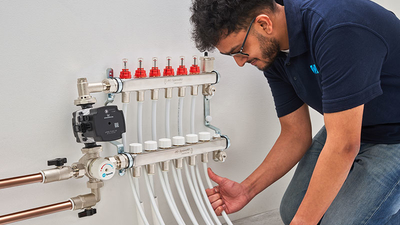Installing underfloor heating: advice from JG Underfloor

Plumbing and heating installers know the importance of ensuring every aspect of their installations are fit for the future. To achieve that, keeping up to date with trends and using market-leading solutions from trusted suppliers is key.
The same is true when it comes to underfloor heating (UFH). As homeowners look to improve the efficiency of their properties, transform interior comfort and reduce running costs, investments in UFH are increasing right across the UK. To meet this growing demand, installers are spending more time installing underfloor heating, often retrofitting systems into existing homes.
Whether you’re a seasoned UFH installer, or you’re just beginning your journey, we’ve outlined some installing underfloor heating advice to help you get every job done well.
Preparation is key
Before getting started on a new UFH project, installers will need to familiarise themselves with the property they’re working on.
At this point, there are some key considerations when installing underfloor heating. From the construction of the floors where underfloor heating is to be laid, through to the heat source that will be feeding the new system, these details will determine how a project is tackled – and how successful it will be.
With every project being different, taking the time to understand individual characteristics will enable installers to select the most appropriate system and design it for maximum efficiency.
Three key considerations for installing underfloor heating
While there are lots of variables at play, our installing underfloor heating advice consists of three key things installers need to keep in mind from the outset.
1. Ensuring heat source compatibility
Firstly, there’s the heat source that’s going to be used to feed the new UFH system. As a highly versatile method of home heating, UFH can be used in conjunction with traditional boilers just as seamlessly as brand-new heat pumps, making it a viable heating option for the majority of homes across the UK.
Operating at considerably lower temperatures than traditional radiator systems means less demand is placed on the heat source to adequately heat a home. This makes heat pumps an effective option as they emit lower temperatures than traditional boilers, elevating levels of efficiency across the entire system. However, this can be a more expensive choice for homeowners – and requires installers to be MCS-certified.
Boilers, however, can work just as well with UFH, improving comfort across a property and enhancing efficiency. The lower operating temperatures of UFH place less demand on a boiler than a radiator system would, making it a practical and affordable solution.
Alongside choosing the most appropriate heat source for a specific project, installers will also need to consider the sizing of boilers and pipework. As well as contributing to system efficiency, updates to Part L of the Building Regulations mean that evidence of correct system sizing must be provided to the customer.
2. Floor construction, flooring types and insulation
The next piece of advice when installing underfloor heating is the construction of the floors where UFH is to be installed. Floors will typically be concrete or timber – a factor that will determine the type of system used and how it will be installed.
Solid floors, which are typical on the ground floor of new and existing homes, can benefit from overlay systems – such as those in the JG Underfloor range. This negates the need to dig up floors to install UFH, minimising disruption and complexity. Low-profile UFH systems can also be used to minimise increases in floor height – something which is particularly useful on renovation projects.
Where installers are working with timber floors, UFH installation can be less time consuming and less disruptive. To accommodate the requirements of specific projects, overlay panels, panels that sit within the floor joists, and spreader plates can be used to achieve the best results.
No matter the floor type, there are some common considerations to keep in mind. Floor height is an important factor, directly impacting the practicality of spaces, as is the final floor finish. From wooden flooring through to carpet, homeowners can finish their homes in a way that suits their individual style, however, the flooring may impact system efficiency. Carpet, for instance, may limit the amount of heat transferring into a space, whereas flooring such as tiles, lino and engineered timber can support heat transfer.
3. Location, location, location
With heat source and floor construction considerations out of the way, attention can move to our final piece of advice when installing underfloor heating (in this blog), the manifold – an essential piece of the puzzle that acts as the heart of a UFH system.
The manifold is responsible for distributing water to each UFH zone at the correct temperature, forming the vital connection between the heat source and the underfloor pipework. By controlling the flow rate to each zone, the manifold ensures individual rooms are adequately heated to deliver the desired levels of comfort and efficiency.
To achieve this, the location of the UFH manifold is critical and should be considered from the earliest stage of an installation.
The ideal location for the manifold is at the centre of the system, enabling pipe runs to each zone to remain consistent. In practice, this means that temperatures can be maintained in each zone, minimising losses from the point of distribution and optimising overall system performance.

Working with trusted manufacturers
While no two underfloor heating installations are the same, taking a consistent approach to planning and preparation will help installers to overcome some of the typical challenges encountered on the job. Supporting this process, working with trusted manufacturers can help every job to run smoothly.
As a trusted manufacturer of underfloor heating systems, JG Underfloor – part of the RWC family of brands – can provide a solution for every application, be it a new build property or an older dwelling. Whatever the challenge, installers can fit systems that maximise efficiency, underpin performance and elevate comfort.
But, when working with RWC, the support doesn’t end with the high-performing UFH systems. Our technical team work closely with installers throughout their projects to ensure success – from initial design and CAD drawings through to free on-site technical support for new installers and complex installations.
An installer’s guide to underfloor heating
To find out more about the role of underfloor heating in modern homes and how to install it successfully, download our latest eGuide.
